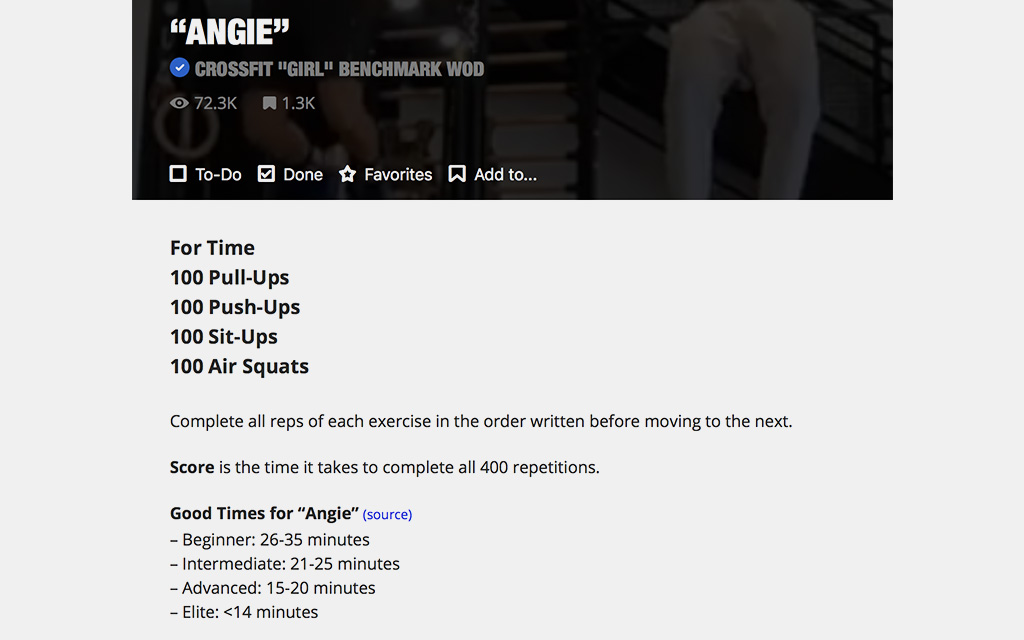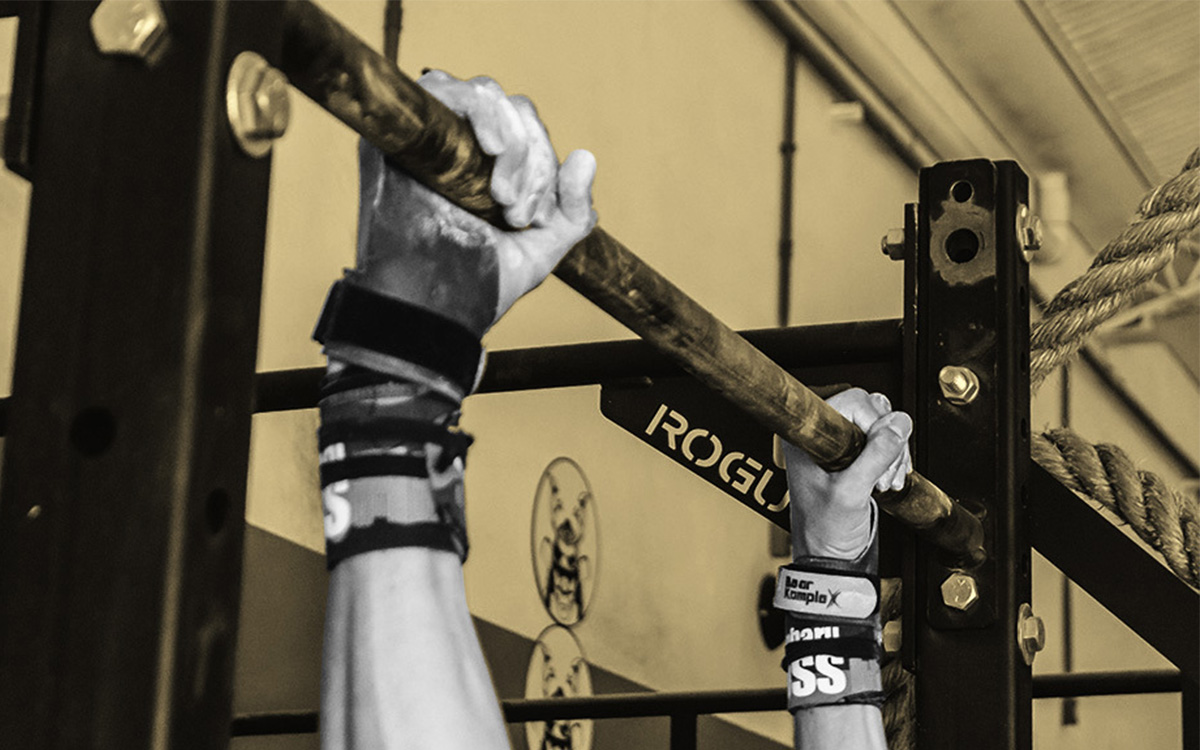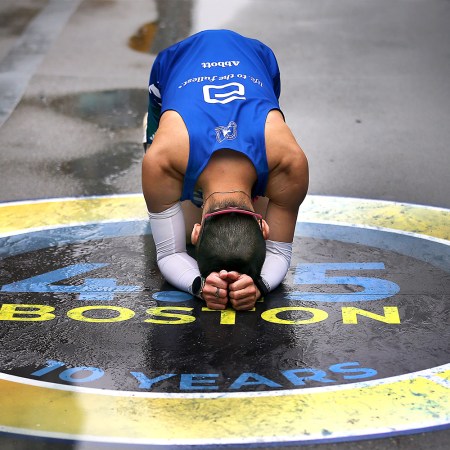Welcome to The Workout From Home Diaries. Throughout our national self-isolation period, we’ll be sharing single-exercise deep dives, offbeat belly-busters and general get-off-the-couch inspiration that doesn’t require a visit to your (now-shuttered) local gym.
I’d been at the bar for 13 minutes, a relative eternity, yet I’d only managed 40 pull-ups. Looking around conspiratorially, as if expecting some disappointed coach or trainer to leap from the bushes, I turned off the timer and cursed under my breath.
A couple CrossFit buddies of mine had texted me early last week, urging me to try out a WOD they’ve turned to repeatedly over quarantine. It’s called “Angie” (the female name is a staple in CrossFit lore; founder Greg Glassman wanted his workouts to sound like storms named by the National Weather Service), and it’s classified as a “benchmark WOD,” which means members of the kipping cult use it to compare fitness levels with others across the sport. I don’t personally belong to a CrossFit gym. What appealed to me — as my friends probably guessed — was the concept of a “counting rep challenge,” a workout predicated on way too many reps, meant to embrace muscular fatigue.
The most famous iteration of that sort of challenge will take place in five weeks, on Memorial Day. It’s called the “Murph,” and it’s a tribute to the late Lieutenant Michael P. Murphy, a Navy SEAL who died in Afghanistan’s Kunal Province in June of 2005. Lt. Murphy’s legacy is well-preserved: he earned the Medal of Honor, he was portrayed by Taylor Kitsch in Lone Survivor, and his name is painted across combat training pools, post offices and even a naval destroyer ship. But the Murph Challenge, a social media darling over the last few years, has spread his story across the globe and become known as the Everest of fitness trials. The challenge was reportedly one of Lt. Murphy’s favorite workouts, which he referred to as “Body Armor.” It involves a one-mile run, 100 pull-ups, 200 push-ups, 300 air squats, and another one mile run.
On Memorial Day, participants honor Lt. Murphy’s sacrifice by performing the routine, posting a sweaty photo online, and donating to the Lt. Michael P. Murphy Memorial Scholarship Foundation, which has raised over $1 million since 2014. It’s provided dozens of scholarships over the years, and aided in the construction of a sea cadet facility in Long Island, New York, where Lt. Murphy is from. It’s a nice thing, done to remember a man who’d protected others his entire life (long before he was a lieutenant, Murphy was famous for defending classmates with special needs and a local homeless man from bullies). But it’s also one hell of a workout, which is why it got so popular in the first place. The fitness faithful wear a 20-pound vest during the workout, as Lt. Murphy did, and the utter absurdity of that is exactly why the challenge is now so popular, year after year. There is an official leaderboard for how long it takes people to complete it.
In other words, the Murph Challenge is also a competition. Of course it is. The CrossFit community just can’t help themselves. The third-best time on the leaderboard wasn’t even American; it came from a gym just south of London. There’s nothing particularly wrong with the Murph’s popularity, from a purely fitness perspective. Like marathons, there is value and fun to be had in an over-the-top novelty race. But when other “counting reps routines” with far less pageantry and tradition insist on being timed, and timed frequently (like “Angie,” for instance) their supposed status as fitness benchmarks is unhealthy. Especially as those exact workouts, performed without what a screenwriting professor would call “the clock threat menace,” can actually act as an opportunity to accrue reps, hone form, stave off injury, and shock the body over an extended period of time — all without the crushing fear of “losing” to the rest of the community.

I don’t know how long exactly it took me to finish 100 pull-ups. I would guess somewhere in the 50-minute range. I originally planned on attacking them in 20 groups of five at a time, but over the first half, that quickly devolved into something like 21 sets of two, and more sets than I’d care to admit of half-reps. I texted one of my friends halfway through; he’d performed “Angie” in its entirety in less than 20 minutes. The workout includes 100 pull-ups, 100 push-ups, 100 sit-ups and 100 air squats, and the catch is that each exercise must be completed before the participant is allowed to progress to the next exercise. Meaning, the regimen gets easier (and faster) as you advance from one move to the next. But starting by having to finish 100 pull-ups is like staring up at the Cliffs of Insanity in The Princess Bride. No matter your grit or good intentions, your arms will start to fail you. And all the while, the clock is ticking. All I want right now is to be allowed to do 100 push-ups, I thought a couple times. I was losing it.
My friend encouraged me to get my lower body into it, to use momentum to swing up and start totaling the reps. Without using the word explicitly, he was referring to “kipping,” a method CrossFitters often use to explode from the hips and angle the chin over the bar, earning reps once the arms have nothing left. Kipping has long been unfairly targeted by the internet’s dedicated community of never-CrossFitters. To be sure, they wouldn’t qualify as pull-ups for grade schoolers taking the Presidential Fitness Test. But they’re not completely useless. As a Men’s Health article pointed out last year, the herky-jerky motion is a must-know for gymnasts, trapeze artists and even parkour performers. Barring a severe career shift, though, I’m currently none of those things.
So after I turned the timer off, I dusted off my pride for a moment or two before deciding to stick to strict pull-ups. The kind that I knew prioritized that all-important credo of time under tension, the kind that engage 21 different muscles, which aim for a beloved trainer phrase “scapular contractions,” instead of whatever the clock-fighting alternative could be called; you might say “scattered convulsions.” The result, all told, was an hour-and-a-half workout. Seriously. I rarely go on Sunday long runs that last that long, and have never strength trained for so many minutes before. When I finished the pull-ups, I kept the same attention to form for the push-ups, sit-ups and air squats — protecting the back all the while, hitting my spots, taking my time — and what should’ve been a hellish stretch actually felt like freedom compared to my battle with the bar.
After it was all over, I took another peak at the “Angie” description; according to the chart, I was an hour worse than a Beginner, and I’m a fitness writer who exercises six days a week. The conclusion, then, seemed fitting. Elements of CrossFit teach proper form, of course, and time under tension, and lots of other of-the-moment credos for putting in work at the gym without exiting on a stretcher. But arbitrary assessments like “Angie,” if assigned an undue level of importance can affect more than an unstable back — they can unseat self-worth and create shaky goals with dubious endgames. Community fitness is important (and now more than ever), but ideally, it shouldn’t come at a physical cost.
Plus, and I’d like to really emphasize this point, I actually loved “Angie.” It’s a great workout. But its best elements — its penchant for inducing muscular fatigue, its “fun” factor, its ability to shock the body — don’t just go away when the workout is slowed down and respected. My arms are an absolute trainwreck right now. I couldn’t shoot a basketball yesterday, and my right shoulder was sore after taking a phone call today. And the workout stuck with me, obviously. I don’t write a column every time I lift a dumbbell.
So, a final word? Do the Murph Challenge next month. Time it, donate, have fun. It’s once a year and it deserves all the attention it gets. But for all other “counting rep challenges” like it, slow down. Make sure all that quantity is quality. If you’d rather avoid the CrossFit sphere entirely, try a workout like Luke Zocchi’s 1000 Challenge. He’s Chris Hemsworth’s trainer, and he does a diabolical circuit of 1,000 different reps — five sets of eight moves done 25 times each — that tries out rarely seen exercises like Hindu push-ups and kick sits. And if you do want to try a CrossFit workout, make use of the brand’s entire library of benchmark workouts at your own pace. The second I can feel these arms again I’ve got a date — a slow date — with Barbara.
Whether you’re looking to get into shape, or just get out of a funk, The Charge has got you covered. Sign up for our new wellness newsletter today.























